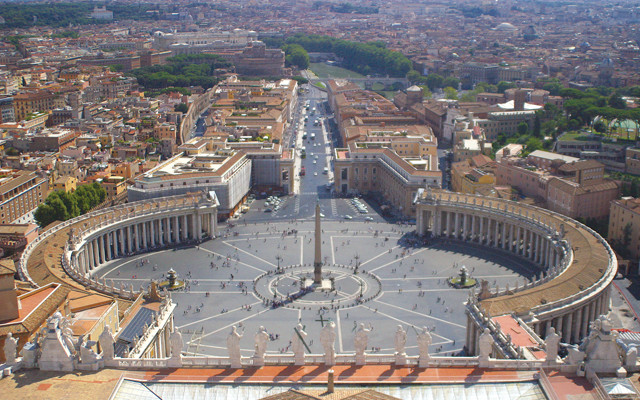
by Cassandra Willyard Tuesday, September 1, 2015

A statue of Galileo is set to be erected in the Vatican gardens next year, just in time for the 400th anniversary of Galileo's invention of the telescope. Credit: Christopher Keane.
More than three and a half centuries after the Vatican accused famed Italian astronomer Galileo Galilei of heresy, Pope John Paul II officially welcomed him back into the fold, dismissing the whole messy episode as a “tragic mutual incomprehension.” At issue in what has become known as the “Galileo affair” was planetary motion. In the early 1600s, nearly all Europeans believed that the universe revolved around Earth. Not only was the idea widely supported by most scientists, but scripture seemed to dictate that it was so. Theologians pointed to biblical passages such as Psalm 104 — which proclaims, “[The Lord] set the earth on its foundations; it can never be moved” — as evidence of a geocentric system.
Nicolaus Copernicus was one of the first to suggest an alternate theory. In 1543, he published “On the Revolutions of the Celestial Orbs,” which suggested that Earth orbits the sun rather than vice versa. Initially, the book caused little distress within the Roman Catholic Church, perhaps because nearly every scholar rejected the central premise (or perhaps because it was dedicated to Pope Paul III).
All that changed, however, in the 1600s. Galileo’s telescopes allowed him to view the heavens with greater clarity than anyone had ever viewed them before. His observations led him to suspect that Copernicus was right — a position he expressed in an increasingly vocal manner. Eventually, the church took notice. It placed Copernicus’ book on the Index of Forbidden Books and cautioned Galileo to tread cautiously. In 1624, Pope Urban VIII warned Galileo that he should discuss Copernican theory only as a purely mathematical hypothesis.
But in 1632, no longer able to hold his tongue, Galileo published “Dialogue Concerning the Two Chief World Systems.” The book, which outlined his pro-Copernican views, “represents a downright roguish attempt to comply with [the Church’s] order in appearance and yet in fact to disregard it,” wrote Albert Einstein in a foreward to the 1953 edition. “Unfortunately,” he continued, “it turned out that the Holy Inquisition was unable to appreciate adequately such subtle humor.”
Indeed, the Vatican was quick to respond. In 1633, the Church ordered that Galileo be brought to Rome to face the Inquisition. After 18 days of interrogation, he was convicted of heresy and asked to renounce his Copernican beliefs. Rather than be burned at the stake, Galileo obligingly rejected “the false opinion that the Sun was the centre of the universe and immovable and that the Earth was not the centre of the same and that it moved.” He lived out the remainder of his days under house arrest and died eight years later, frail and blind.
Galileo remained a devout Catholic even after the Inquisition. But whether he was truly repentant is a source of some debate. Legend has it that the astronomer muttered “and yet it moves” after renouncing the idea that Earth circles the sun as heretical.
By the mid-1600s, Copernican theory was widely accepted within the scientific community. Yet it took another century before the Vatican showed any signs of softening. In 1734, the Church finally allowed a mausoleum to be built to house Galileo’s remains. And by 1835, the Church had removed Galileo’s “Dialogue Concerning the Two Chief World Systems” as well as Copernicus’ book from the Index of Forbidden Books.
Further concessions came in 1979. During an address at the Pontifical Academy of Sciences, Pope John Paul II said, “I hope that theologians, scholars and historians, animated by a spirit of sincere collaboration, will study the Galileo case more deeply and, in a loyal recognition of wrongs from whatever side they come, will dispel the mistrust that still opposes, in many minds, a fruitful concord between the Church and the world.” In 1981, the “Galileo Commission” was formed to do just that. And in 1992, after more than a decade of investigation, the commission reached a new verdict: not guilty.
Next year, the Vatican will unveil a final tribute: A statue of Galileo is set to be erected in the Vatican gardens in time for next year’s celebration of the 400th anniversary of Galileo’s invention of the telescope. Perhaps the Church has developed an appreciation for subtle humor and will inscribe it with the words, “And yet it moves.”
© 2008-2021. All rights reserved. Any copying, redistribution or retransmission of any of the contents of this service without the expressed written permission of the American Geosciences Institute is expressly prohibited. Click here for all copyright requests.